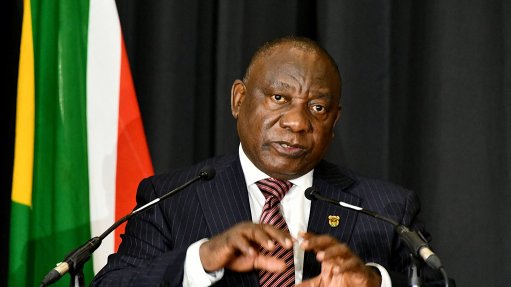
President Cyril Ramaphosa
A R300-billion investment pipeline has been identified under South Africa’s Green Hydrogen National Programme, which has been designated as a Strategic Integrated Project (SIP) for accelerated development under the country’s Infrastructure Development Act.
Speaking at the South Africa Green Hydrogen Summit in Cape Town on Tuesday, President Cyril Ramaphosa argued that government was seeking to use the programme to position the country as an “investment destination of choice” as countries in Europe and Asia sought to import green hydrogen to both decarbonise and bolster their energy security.
South Africa, the President said, had the potential to produce up to 13-million tons of green hydrogen and derivatives a year by 2050.
To do so would require between 140 GW and 300 GW of renewable energy, which would represent a massive scale up in a context where South Africa had procured only about 7 GW of wind and solar since 2011.
South Africa’s existing renewables generators are currently insufficient even to cover the electricity supply gaps left by Eskom’s failing coal fleet, which has resulted in the country entering its most intensive period of loadshedding since power cuts were first introduced more than a decade ago.
Ramaphosa said South Africa’s strategy would embrace the export of green hydrogen and derivative products, such as green steel, sustainable aviation fuel, ammonia and fertilisers. The country would also seek to position itself to manufacture electrolysers, fuel cells and renewable-energy components.
He again stressed South Africa’s “inherent” green hydrogen production advantages, owing to its world-class wind and solar endowments.
These advantages were amplified, moreover, by the fact that companies such as Sasol and PetroSA had expertise in using hydrogen in the production of synthetic fuels and chemicals, with South Africa already producing 2.4-million tons of grey hydrogen yearly for domestic consumption.
“We are driving regulatory and legislative reform to make our economy more competitive, to attract more investment and to create more jobs,” he added.
A total of 19 green hydrogen projects had been identified for development, nine of which having been formally registered with Infrastructure South Africa, an initiative of the Ministry of Public Works and Infrastructure and The Presidency to accelerate infrastructure investment.
Public Works and Infrastructure Minister Patricia de Lille announced that the Green Hydrogen National Programme had been included in an updated list of SIPs to be listed in an upcoming Government Gazette.
Projects identified as SIPs are theoretically placed on an expedited path to development, with prescribed and shortened timeframes for various project approvals and authorisations.
De Lille confirmed that the Gazette would include the Prieska Power Reserve, the Ubuntu Green Hydrogen Project, the Hydrogen Valley developments, the Boegoebaai Green Hydrogen Development and the Saldanha Bay Hydrogen Project.
Providing an update on the flagship Boegoebaai project, Ramaphosa said that Sasol and the Northern Cape provincial government had made significant progress on the master plan for a green hydrogen special economic zone (SEZ), which aims to support 40 GW of electrolyser capacity by 2050.
“This would require approximately 80 GW of renewable energy, which is almost double South Africa’s current installed electricity generation capacity.
“Transnet has issued a request for proposals for the development of the port and rail project, which could see the port developed by 2028.”
Western Cape Premier Alan Winde highlighted that he and Northern Cape Premier Zamani Saul had signed heads of agreement for the two provinces to collaborate on the so-called Western Southern African Development Community Green Hydrogen Corridor to produce green hydrogen for the global and local markets.
Under the agreement, the provinces, which both have green hydrogen strategies, will seek to kickstart projects such as green iron-ore smelting at the mothballed ArcelorMittal South Africa facility in Saldanha Bay and the Boegoebaai SEZ.
Winde also flagged the potential for cooperation with neighbouring Namibia, which was moving ahead with plans for an $11-billion, 350 000 t/y green hydrogen project.
Namibia presidential economic adviser James Mnyupe stressed the potential for the green hydrogen projects in South Africa and southern Namibia to complement each other in unlocking a large-scale green hydrogen industry by developing cross-border pipeline and electricity infrastructure.
“We envision a 2 500-km pipeline from Lüderitz all the way to Saldanha, with a T-junction all the way to Secunda as well,” Mnyupe said, referring to Sasol’s petrochemical hub, in Mpumalanga, which currently uses grey hydrogen to produce fuels and chemicals.
He estimated the cost of such a pipeline to be €20-billion and stressed the need for cooperation between the two countries to support such an ambition.
“We cannot do projects like that alone,” Mnyupe said.